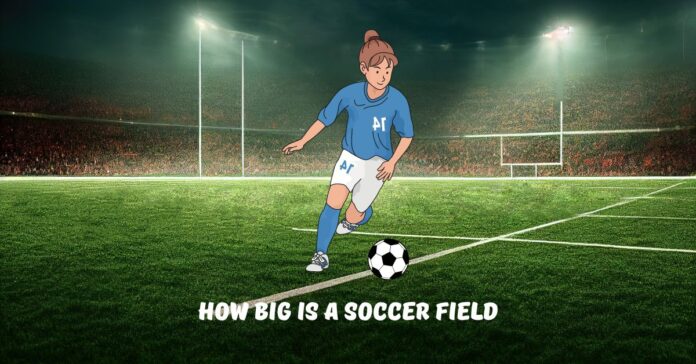Overview
The great game of soccer is played on various forms of fields. How big is a soccer field? To Understand that the measurement of a soccer field is necessary not only for a player but also for coaches and planners. This is true for different games, from casual 3 v 3 games to training professional games. Knowing the correct size of the field will help ensure that fair play with efficiency takes place.
Standard Soccer Field Dimensions
FIFA, the international governing body for the sport of soccer, regulates dimensions of standard soccer fields. According to FIFA regulations, the length of the soccer field is supposed to fall between 100 and 130 yards, or 90 and 120 meters, while the width falls within the range of 50 to 100 yards, or 45 to 90 meters. This allows flexibility in regards to the level of play and available space.
Key areas include the penalty area, goal area, and center circle. For example, the penalty area is 18 yards from the goal line and extends across 44 yards of the field. This consistency in markings allows different fields to be similar in many ways.
Professional Soccer Field Dimensions
Professional soccer fields are utilized in top leagues around the world and generally meet more specific dimensions set by FIFA. Most professional fields are about 115 yards in length and about 75 yards in width. Such standardization helps in giving a level playing field for all different venues.
That being said, well-known stadiums such as Wembley in London and Camp Nou in Barcelona highly regard these dimensions. Minimal changes do occur, however, which can be done to accommodate specific requirements or team preferences of the teams playing at home.

Compatibility of Soccer Field size with Basketball
Size and Space:
A standard soccer field is much larger as compared to a basketball court. The standard length of a usual soccer field varies from 100-110 meters (110-120 yards) and the width from 64-75 meters (70-80 yards); at the same time, the basketball court is long of 28 meters (94 feet) and wide of 15 meters (50 feet).
The large size of a soccer field means it can easily accommodate a basketball court within its area.
Multi-Purpose Use:
Some sports facilities are designed for multi-purpose use, hosting a soccer field with markings or configurations allowing temporary basketball courts to be set up.
In addition, portable basketball hoops can also be placed on a portion of a soccer field for training or playful purposes.
Surface Considerations:
soccer is generally played on either grass or artificial turf while basketball is played on a hard, smooth surface typically made of wood or asphalt.
It could be a matter of logistical changeovers, from laying down a temporary hard surface over part of the soccer field.
Adequacy of the Surface:
Futsal is a version of indoor soccer with a smaller, heavier ball that can use the hard surface of a basketball court very well. Minor changes that will allow what is field goal in basketball courts to become futsal courts include marking out futsal lines and putting out smaller goals.
How big is a soccer field in feet?
These metric dimensions in feet give a better understanding to those who are used to the imperial system. A normal soccer field is about 300 to 390 feet in length, with a width of 150 to 300 feet. For professional fields, this generally means a length of about 345 feet and a width of 225 feet.
How big is a professional soccer field?
Professional soccer fields do usually take to the higher dimension limits as set by FIFA for field space and area, allowing for maximum utilization of area for increased speed in playing. how big is a pro soccer field? For example, in the English Premier League, the length is often around 345 feet, while the width is about 225 feet. This creates a field that is regular enough for teams and viewers alike to become accustomed to.
How big is a soccer field for 3 v 3?
Small-sided games such as 3 v 3 are played on considerably smaller fields. Their dimensions are usually around 30 x 20 yards, or 27.4 x 18.3 meters. A field of this size truly allows for fast and skilled play. It would thus be more appropriately used for younger players or training sessions targeting specialized skills.
Youth Soccer Field Dimensions
Youth soccer fields are of different sizes to accommodate the various ages and developmental stages. As an example, Under-8 players should play on a field that measures 25×15 yards, while for Under-12 players, a field measuring about 80×50 yards could be appropriate. Properly sized age-appropriate field size is very important for player development, which makes the game both enjoyable and successful.
Indoor Soccer Field Dimensions
Indoor soccer fields are usually smaller than their outdoor counterparts, usually measuring 200 by 85 feet. The field is covered and, thus, enables play in all weather conditions; artificial turf is also used to simulate the playing surfaces outdoors.
Soccer Field Dimensions for Training
These training fields can be quite different in size and are often tailor-made to stress particular aspects of the game. A typical training field might be half the size of a full field or even divided into smaller segments for drills and practice matches. This flexibility helps coaches tailor their sessions to the needs of their teams.
Comparison of Sports Field Dimensions
soccer field is among the biggest sports fields. In comparison, an American football field measures 100 yards by 53.3 yards while a baseball field varies. However, generally speaking, all of these fields are smaller in size than a soccer field. This goes to show how much space soccer needs to accommodate its dynamic and expansive nature.
Area Calculation of Soccer Field
To find the area of a soccer field, one multiplies the length times the width. For a regular professional field, that would be approximately 86,625 square feet, using 345 feet times 225 feet. This is often useful to know for maintenance, construction, and event planning purposes.
3D Models Soccer Field
Such 3D models of soccer fields are some of the most useful tools in the way of planning and visualization. They allow a team or an architect to see just how changes in dimensions would affect gameplay and help coaches develop play strategies. Such models could also be used in video games and training simulations, thus making them more interactive for players.
Soccer Field Maintenance
It also involves regular mowing, irrigation, and marking of the soccer field. Proper maintenance will keep the field safe to play on and preserve its dimensions and the quality of its surface. Other routine cares involve aerating the soil, reseeding grass, and checking for wear and tear.
Soccer Field Dimension Customization
These would also involve customized dimensions for certain needs, like smaller fields for youth leagues or larger fields for training. Adjustments could also be made for specific events or community requirements, showing that there is flexibility and adaptability to soccer field layouts.
Conclusion
The field dimensions are important to understand, be it for the players playing on it, the coaches teaching on it, or the planners planning for it. From general standard FIFA laws to the details of professional and youth fields, these dimensions ensure the game is conducted as fairly and efficiently as possible. Whether one has to determine area maintenance or personalize a field with an event in mind, this knowledge becomes critical.











